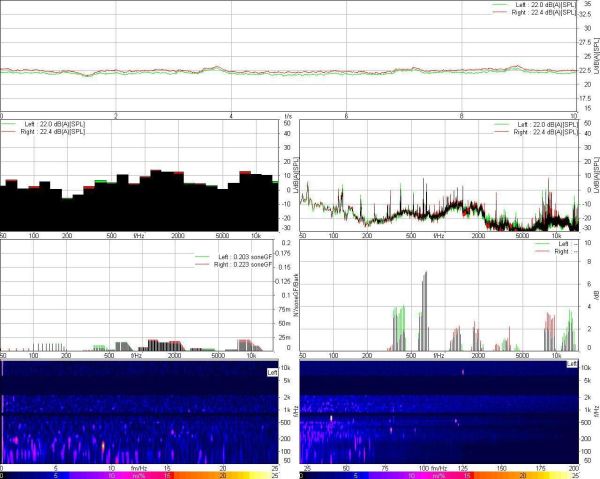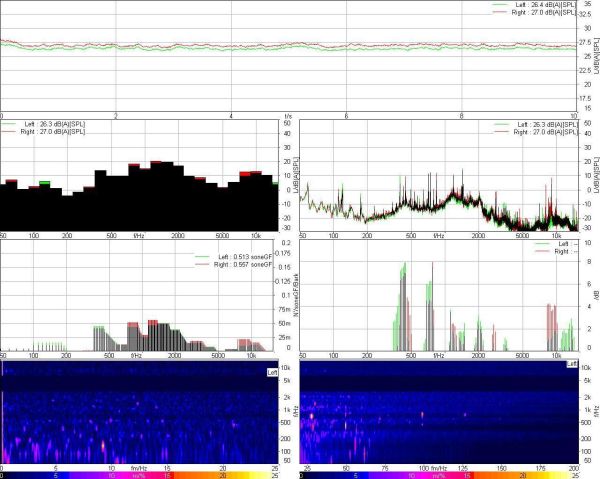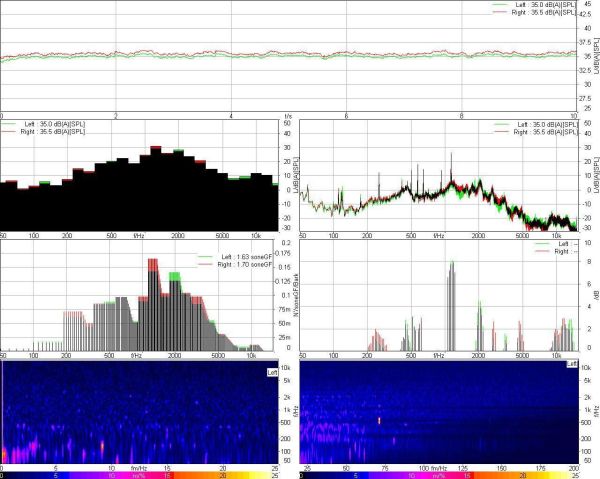ASRock CoreHT 252B Review
by Ganesh T S on September 2, 2011 3:45 AM EST- Posted in
- HTPC
- Intel
- ASRock
- Media Streamer
HTPC enthusiasts are rightly concerned about the noise factor, heat and power consumption, ease of usage and many other criteria. We will tackle each of these concerns one by one in this section.
Noise
ASRock doesn't make any claims about the quietness of the system in their marketing material. We were pleasantly surprised upon looking at the noise reports. In the set of pictures below, a professional sound level detector was placed less than 2 ft away from the CoreHT, and the sound level measurements were taken in various HTPC scenarios. The unit has a noise level of less than 36 dB at full load (for both CPU and GPU). In this respect, it is actually similar in performance to the earlier SFF HTPCs from ASRock.
22.4 dB at Idle
27 dB during Disc Playback
35.5 dB at Full Load (Prime95 + Furmark)
Power Consumption
In order to get an idea of the power consumption numbers, the Prime95 and Furmark benchmarks were let run overnight to keep both the CPU and GPU completely loaded for an extended duration. Under these extreme conditions, we found the average power consumption to be around 62.8 W. At idle, the average power consumption was around 18 W.
These type of power consumption numbers have been enabled by ASRock's choice of going in for a notebook platform instead of a desktop configuration. This has resulted in a smaller form factor case design for the mini-ITX motherboard. Since there is not much heat to be dissipated, the cooling system is also appropriately small and silent.
Ease of Use
HTPC enthusiasts are concerned about how easy it is for their system to come out of standby. Existence of HDMI handshake issues upon return from standby is also a deal breaker for many. Fortunately, the CoreHT 252B has no issues in these two aspects. As long as the AC power adapter is connected to the system, the bundled MCE remote can be used to boot the system (even if the PC had been shut down previously). In order to shorten the boot times, ASRock supplies an Instant Boot utility. Using this, whenver the CoreHT is shut down, it boots up once again and shuts down before the power can be safely removed. Upon power up, the boot up is instantaneous. The MCE remote can also be used to bring the PC out of sleep mode.
Power users can also take advantage of the AXTU (ASRock eXtreme Tune Up) utility for greater overclocking control.
Within Windows, the MCE remote can be made to work with a variety of applications such as XBMC, MediaPortal, MPC-HC and of course, Windows 7 Media Center. Blu Ray players such as PowerDVD and ArcSoft TMT can also be controlled with the help of the MCE remote. For the ideal I/O scenario, one probably needs to purchase a wireless keyboard / mouse combo.













54 Comments
View All Comments
Death666Angel - Friday, September 2, 2011 - link
<<Well, the reviewer only used Windows, hence assuming that one pays for it.>>That would be true, except for the part where in the table on the first page, he writes:
"Operating System Windows 7 Home Premium 64-bit (Retail unit is barebones)"
I agree, however, that he could have stated it clearer in the text when he mentioned the software being shipped with the system ("Our review unit shipped with Windows 7 x64 Ultimate and a OEM version of Cyberlink PowerDVD for Blu-Ray playback.").
ganeshts - Friday, September 2, 2011 - link
Guys, I am keeping track of the developments in the Linux HTPC space.As soon as we can get to a point where it is possible to play Blu-rays with menus (we can already playback encrypted Blu-rays with MakeMKV installed, just not with menus -- this was the state when I last looked at it), we will carry out a detailed Linux HTPC article.
Rick83 - Friday, September 2, 2011 - link
Thanks, looking forward to that!bobbozzo - Friday, September 2, 2011 - link
Hi Ganesh,I don't care about BD so I'd like to see a review even if BD menus don't work.
Thanks for all the HTPC articles!
Miles Prower - Saturday, September 3, 2011 - link
I'm considering buying this machine too, as both a lightweight desktop PC (hey, why not) and a HTPC. Both solutions running Linux.I'd llove to see a review considering XBMC performance and hardware support!
cjs150 - Friday, September 2, 2011 - link
"The unit has a noise level of less than 36 dB at full load "Not good enough. The system needs to be much better 30dB or less. Then there is the issue of how noisy is the Blu-ray drive. In my AV rack the one aspect which really annoys me is the Sony Blu ray player which is clearly audible at quiet points in movies. So would really like to know how loud the optical drive is (why do case manufacturers no include some dampening?)
Having said that it is clearly a very good system . Problem is that Zotac have just announced their AD10 nano system. Whilst it is over priced and lacks an optical drive (not a problem for me as store movies to NAS), in a main room it just looks a far better piece of kit, and a lot smaller (and allegedly quieter)
pvdw - Friday, September 2, 2011 - link
"27 dB during Disc Playback"cjs150 - Friday, September 2, 2011 - link
Oops missed that in the charts.Much better, but I do wonder how much of that noise is due to the Blu ray drive - 22.4 dB on idle and 27 dB on Blu ray playback does not really help me - was this playback from HD or from the optical drive. I can believe the number if from HD, I do not believe the number if from optical drive, but if it is correct then I am impressed. Maybe it is just me, but case manufacturers have spent some time putting vibration dampening grommets for hard disks but never for the optical drives - why? A bit of care might reduce the noise considerably.
The problem is that we keep getting quoted dB and how something is so quiet it is effectively silent when clearly it is not. The standard I work to is very simple. If I can hear a computer during a quiet section of a movie or a song, than it is too loud.
ganeshts - Friday, September 2, 2011 - link
Disc = optical drive. The extra noise is due to the operation of the ODD. Yes, I agree with your metric that if people hear it, it is noisy. However, different people have different tolerance / hearing levels. So, you do need to have some sort of base metric to compare against. For example, at 2 ft, I find 36 dB quite audible. But, only during quiet scenes in the video.Rick83 - Friday, September 2, 2011 - link
note that the measurements were done at 2 feet and not the more or less standardized meter. I'm not going to make the transformation now, as I'm not to keen to get into exponential scaling at this time of day, but it's always important to keep the context of db(A) measures in mind when comparing values.